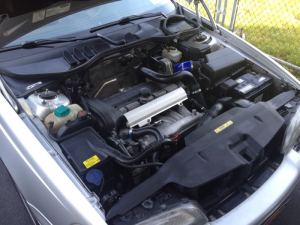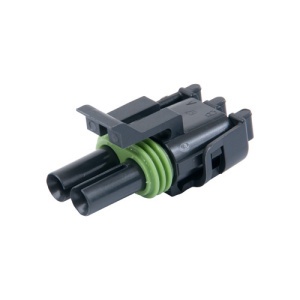One of the first things I do upon taking ownership of a car is clean the engine bay. Not only do I despise seeing dirt under the hood, a clean engine makes it easier to work on. Plus, your hands stay cleaner and tools don't get mucked up as quickly. Cleaning under the hood is simple on modern cars. Most of them, like my Volvo S70, use electrical connections with some form of "Weatherpack" style connector.
This eliminates a lot of time consuming preparation steps, which may involve using plastic bags to cover areas you don't want water getting into. With Weatherpack connectors, moisture is sealed out and vital electrical connections are protected from the harsh conditions that an engine bay experiences. You can usually spray water directly at these with no ill effects, although you shouldn't blast them for no reason.
Here's how I usually go about cleaning an engine bay:
- Warm up the engine a bit. A super hot engine isn't optimal, since it will boil off whatever you spray on. Idling for no longer than 5 minutes should be sufficient.
- Remove loose debris, like leaves, pine needles, and errant tools/gloves/rags left behind.
- Ensure everything is closed. This means, make sure your airbox is properly sealed, check if your oil cap is tight, dipsticks are down, and spark plug wires are fully seated. Engines are designed to function through moist conditions, but only if everything is attached properly.
- Spray down the engine bay with a degreaser/detergent, such as Simple Green. Pretty much everything with dirt or oil on it can be soaked in this solution.
- Let soak for 5 minutes.
- Hose down thoroughly. I like to use a "Gentle rain" setting on my hose as it doesn't really have the ability to force water into anywhere it shouldn't be. The dirt should melt off of your valve cover, hoses, air box, and everywhere else you sprayed.
Now that your engine is clean, here are a few immediate benefits you'll realize:
- Your mechanic will thank you
- Women like a clean engine
- Simple maintenance won't make your hands look awful

- Potential buyers will feel that the car was well taken care of, and may be less inclined to haggle.
This is only an amateur's take on engine cleaning - more professional methods may involve using steam or other solvents, with steam being the safest and most "green" way of going about this as you rarely need soaps or degreasers. But for many, a simple soap or citrus based degreaser and a hose is the most cost effective way to clean their engines.












